The Diagenetic Alteration of the Carbonate Rocks from the Permian Qixia Formation as Response to Two Periods of Hydrothermal Fluids Charging in the Central Uplift of Sichuan Basin, SW China
Abstract
:1. Introduction
2. Geological Setting
3. Methods
4. Results
4.1. Lithology
4.1.1. Fine-Medium Crystalline Dolostone
4.1.2. Meso-Coarse Crystalline Dolostone
4.1.3. Dolomitic Limestone
4.1.4. Limestone
4.2. Elements
4.3. C, O, Sr Isotopes
4.4. Homogenization Temperature of Fluid Inclusions
5. Discussion
5.1. Timing and Stages of Dolomitization
5.2. Dolomitization of Dolostone Formed by Hydrothermal Fluids
5.3. The Influence of Two Stages of Hydrothermal Fluid Activity on the Dolostone Formation
6. Conclusions
Author Contributions
Funding
Institutional Review Board Statement
Informed Consent Statement
Data Availability Statement
Acknowledgments
Conflicts of Interest
References
- Li, Z.; Ou, J.; Chen, X.; Li, F.; Wang, X.; Tan, X. Characteristics and main development controlling factors for lower Permian dolomite reservoirs in Chuanzhong region. Pet. Geol. Oilfield Dev. Daqing 2017, 36, 1–8. [Google Scholar]
- Liu, J.; Zheng, H.; Liu, B.; Liu, H.; Shi, K.; Guo, R.; Zhang, X. Characteristics and genetic mechanism of the dolomite in the Middle Permian Maokou Formation, central Sichuan area. Acta Pet. Sin. 2017, 38, 386–398. [Google Scholar]
- Wang, J.; Gu, Y.; Tao, Y.; Qiang, Z.; Qiang, S.; Jiang, C. The model of dolomitization jointly controlled by two-episode fluids in Maokou Formation in central Sichuan Basin. Acta Sedimentol. Sin. 2016, 34, 236–249. [Google Scholar]
- Zhong, Y.; He, B.; Roland, M.; Xu, Y. CA-TIMS zircon U-Pb dating of felsic ignimbrite from the Binchuan section: Implications for the termination age of Emeishan Large Igneous Province. Lithos 2014, 204, 14–19. [Google Scholar] [CrossRef]
- Tian, J.; Lin, X.; Guo, W.; Zhang, X.; Huang, P. Geological significance of oil and gas in the Permian basalt eruption event in Sichuan Basin, China. J. Chengdu Univ. Technol. 2017, 44, 14–20. [Google Scholar]
- Feng, K.; Xu, S.; Chen, H.; Dong, Y. Genetic of Middle Permian dolomite in the southwestern Sichuan Basin: Evidence from strontium isotope and rare earth elements. Carsologica Sin. 2018, 37, 659–670. [Google Scholar]
- Yang, Y.; Zhang, Y.; Xie, C.; Chen, C.; Zhang, X.; Chen, S.; Gao, Z. Hydrothermal effect of Middle Permian Qixia Formation in northwest Sichuan Basin and its effect on reservoirs. Lithol. Reserv. 2019, 31, 44–53. [Google Scholar]
- Zhang, T.; Lin, J.; Han, Y.; Wang, Z.; Qin, J.; Zhang, R. Pattern of hydrothermal dolomitizationin the Middle Permian Maokou Formation, eastern Sichuan Basin, and its alteration on reservoirs herein. Oil Gas Geol. 2020, 41, 132–143. [Google Scholar]
- Ma, X.; Yang, Y.; Wen, L.; Luo, B. Distribution and exploration direction of medium- and large-sized marine carbonate gas fields in Sichuan Basin, SW China. Pet. Explor. Dev. 2019, 46, 1–15. [Google Scholar] [CrossRef]
- Yang, C.; Wen, L.; Wang, T.; Luo, B.; Li, M.; Tian, X.; Ni, Z. Timing of hydrocarbon accumulation time for paleo-oil reservoirs in Anyue gas field in Chuanzhong uplift. Oil Gas Geol. 2020, 41, 492–502. [Google Scholar]
- Du, J.; Zou, C.; Xu, C.; He, H.; Shen, P.; Yang, Y.; Li, Y.; Wei, G.; Wang, Z.; Yang, Y. Theoretical and technical innovations in strategic discovery of a giant gas field in Cambrian Longwangmiao Formation of central Sichuan paleo-uplift, Sichuan Basin. Pet. Explor. Dev. 2014, 41, 268–277. [Google Scholar] [CrossRef]
- Zou, C.; Du, J.; Xu, C.; Wang, Z.; Zhang, B.; Wei, G.; Wang, T.; Yao, G.; Deng, S.; Liu, J.; et al. Formation, distribution, resource potential and discovery of the Sinian−Cambrian giant gas field, Sichuan Basin, SW China. Pet. Explor. Dev. 2014, 41, 278–293. [Google Scholar] [CrossRef]
- Kang, Y. The Formation and development of paleo-uplift in central Sichuan and its oil/gas prospect. Exp. Pet. Geol. 1988, 01, 12–23. [Google Scholar]
- Gan, Z. Discussion on Middle Sichuan Paleouplift from Paleozoic tectonic evolution in western Upper Yangtze Platform. Sichuan Geol. J. 1991, 02, 93–100. [Google Scholar]
- Zhang, H.; Jiang, H.; Chen, Z.; Su, W. A review of the research status of Caledonian movement stages in Sichuan Basin and surrounding areas. Bull. Geol. Technol. 2020, 39, 118–126. [Google Scholar]
- Mei, Q. Tectonic Evolution and Formation Mechanism of Leshan-Longnvsi Paleo-Uplift, Sichuan Basin; China University of Geosciences: Beijing, China, 2015. [Google Scholar]
- Su, W.; Hu, S.; Jiang, Q.; Zhang, J.; Huang, S.; Jiang, H.; Shi, S.; Wang, K.; Chen, X.; Zhang, H.; et al. Sedimentary responses to the Dongwu movement and the influence of the Emeishan mantle plume in Sichuan Basin, Southwest China: Significance for petroleum geology. Carbonates Evaporites 2020, 35, 108. [Google Scholar] [CrossRef]
- Li, Q.; Li, B.; Xu, S.; Mei, W. Source and accumulation processes of natural gases in the Qixia Formation in the Northwestern Sichuan Basin, SW China. J. Pet. Sci. Eng. 2021, 198, 108236. [Google Scholar] [CrossRef]
- Shen, S.; Zhang, H.; Zhang, Y.; Yuan, D.; Chen, B.; He, W.; Mu, L.; Lin, W.; Wang, W.; Chen, J.; et al. Permian integrative stratigraphy and timescale of China. Sci. China Earth Sci. 2019, 62, 154–188. [Google Scholar] [CrossRef]
- Liu, Z.; Yuan, B.; Huang, X.; Dai, X.; Lin, W.; Mao, L.; Qie, W.; Duan, X.; Li, Z.; Li, G. Division and correlation of Permian Foetation at Maoertang section in northwest Sichuan, China. J. Chengdu Univ. Technol. 2020, 47, 257–273. [Google Scholar]
- Liu, W.; Zhong, D.; Sun, H.; Zeng, X.; Liang, X.; Hu, X.; Li, R.; Peng, S.; Song, Y. Sedimentary characteristics and paleogeomorphic responses of the middle Permian Qixia Formation in the northwestern Sichuan Basin. Acta Sedimentol. Sin. 2021, 39, 1275–1291. [Google Scholar]
- Zhong, Y.; Yang, Y.; Wen, L.; Luo, B.; Xiao, D.; Tan, X.; Zhao, L.; Li, M. Sedimentary environments controlled by tectonics and induced differential subsidence: A perspective in the Permian Liangshan and Qixia Formations, northwestern Sichuan Basin, China. J. Cent. South Univ. 2020, 27, 3398–3416. [Google Scholar] [CrossRef]
- Huang, H.; He, D.; Li, Y.; Wang, B. The prototype and its evolution of the Sichuan sedimentary basin and adjacent areas during Liangshan and Qixia stages in Permian. Acta Petrol. Sin. 2017, 33, 1317–1337. [Google Scholar]
- Wang, H.; Chi, Y.; Zhao, Z.; Jiang, Q.; Lu, G. Karst reservoirs developed in the Middle Permian Qixia Formation of Sichuan Basin and selection of exploration regions. Acta Pet. Sin. 2013, 34, 833–842. [Google Scholar]
- Hu, S.; Tang, X.; Liu, B.; Zhang, B.; Zhang, Y.; Su, C.; Lu, F.; Li, M. Sequence stratigraphic characteristics and geological significance of the Permian Qixia Stage in northwestern Sichuan Basin. J. Palaeogeogr. 2020, 22, 1109–1126. [Google Scholar]
- Lu, F.; Tan, X.; Wang, L.; Tang, Q.; Xiao, D.; Dong, S.; Su, C.; Pan, Z. Characteristics and controlling factors of Dolomite Reservoirs within Shoal—Controlled Karst in the Middle Permian Qixia Formation, Central Sichuan Basin. Acta Sedimentol. Sin. 2021, 39, 456–469. [Google Scholar]
- Keith, M.L.; Weber, J.N. Isotopic composition and environmental classification of selected limestones and fossils. Geochim. Cosmochim. Acta 1964, 28, 1786–1816. [Google Scholar] [CrossRef]
- Chen, R. Application of stable oxygen and carbon isotope in the research of carbonate diagenetic environment. Acta Sedimentol. Sin. 1994, 4, 11–21. [Google Scholar]
- Luo, B.W.; Wei, G.Q.; Yang, W.; Dong, C.Y. Reconstruction of the late Sinian paleo-ocean environment in Sichuan basin and its geological significance. Geol. China 2013, 40, 1099–1111. [Google Scholar]
- Sena, C.M.; John, C.M.; Jourdan, A.L.; Vandeginste, V.; Manning, C. Dolomitization of lower cretaceous peritidal carbonates by modified seawater: Constraints from clumped isotopic paleothermometry, elemental chemistry, and strontium isotopes. J. Sediment. Res. 2014, 84, 552–566. [Google Scholar] [CrossRef] [Green Version]
- Shackleton, N.J.; Kennett, J.P. Paleotemperature history of the Cenozoic and initiation of Antarctic glaciation: Oxygen and carbon isotope analysis in DSDP sites 277, 279 and 281. In Initial Reports of the Deep Sea Drilling Project; Kennett, J.P., Houtz, R.E., Eds.; U.S. Government Printing Office: Washington, DC, USA, 1975; Volume 29, pp. 743–755. [Google Scholar]
- Callen, J.M.; Herrmann, A.D. In situ geochemistry of middle Ordovician dolomites of the upper Mississippi valley. Depos. Rec. 2019, 5, 4–22. [Google Scholar] [CrossRef]
- Geochemistry Teaching and Research Section of China University of Geosciences. Geochemistry; Geological Publishing House: Beijing, China, 1979. [Google Scholar]
- Chen, X.; Zhao, W.Z.; Zhang, L.P.; Zhao, Z.J.; Liu, Y.H.; Zhang, B.M.; Yang, Y. Discovery and exploration significance of structure-controlled hydrothermal dolostones in the Middle Permian of the central Sichuan Basin. Acta Pet. Sin. 2012, 33, 562–569. [Google Scholar]
- Wu, D.; Wu, N.; Gao, J. Paleogeothermal research in Sichuan Basin and its geological significance. Acta Pet. Sin. 1998, 19, 28–334. [Google Scholar]
- Huang, S. A study on carbon and strontium isotopes of late palaeozoic carbonate rocks in the Upper Yangtze platform. Acta Geol. Sin. 1997, 71, 45–53. [Google Scholar]
- Han, X.; Bao, Z.; Xie, S. Origin and geochemical characteristies of dolomites in the Middle Permian Formation, SW Sichuan Basin, China. Earth Sci. 2016, 41, 167–176. [Google Scholar]
- Veizer, J.; Ala, D.; Azmy, K.; Bruckschen, P.; Buhl, D.; Bruhn, F.; Carden, G.A.F.; Diener, A.; Ebneth, S.; Godderis, Y.; et al. 87Sr/86Sr, δ13C and δ18O evolution of Phanerozoic seawater. Chem. Geol. 1999, 161, 59–88. [Google Scholar] [CrossRef] [Green Version]
- Koeshidayatullah, A.; Corlett, H.; Stacey, J.; Swart, P.K.; Boyce, A.; Robertson, H.; Whitaker, F.; Hollis, C. Evaluating new fault-controlled hydrothermal dolomitization models: Insights from the Cambrian Dolomite, Western Canadian Sedimentary Basin. Sedimentology 2020, 67, 2945–2973. [Google Scholar] [CrossRef]
- Kareem, K.H.; Al-Aasm, I.S.; Mansurbeg, H. Structurally-controlled hydrothermal fluid flow in an extensional tectonic regime: A case study of Cretaceous Qamchuqa Formation, Zagros Basin, Kurdistan Iraq. Sediment. Geol. 2019, 386, 52–78. [Google Scholar] [CrossRef]
- Mansurbeg, H.; Alsuwaidi, M.; Salih, N.; Shahrokhi, S.; Morad, S. Integration of stable isotopes, radiometric dating and microthermometry of saddle dolomite and host dolostones (Cretaceous carbonates, Kurdistan, Iraq): New insights into hydrothermal dolomitization. Mar. Pet. Geol. 2021, 127, 104989. [Google Scholar] [CrossRef]
- Beckert, J.; Vandeginste, V.; John, C.M. Relationship between karstification and burial dolomitization in Permian platform carbonates (Lower Khuff—Oman). Sediment. Geol. 2016, 342, 165–179. [Google Scholar] [CrossRef]
- He, P.W.; Xu, W.; Zhang, L.J.; Fu, M.Y.; Wu, D.; Deng, H.C.; Xu, H.L.; Sun, Q.M. Characteristics and Genetic Mechanism of Qixia Formation Dolomite in Moxi-Gaoshiti Area, Central Sichuan Basin. Acta Sedimentol. Sin. 2021, 39, 1–18. [Google Scholar]
- Gregg, J.M.; Sibley, D.F. Epigenetic dolomitization and the origin of xenotopic dolomite texture. J. Sediment. Petrol. 1984, 54, 908–931. [Google Scholar]
- Machel, H.G. Concepts and models of dolomitization: A critical reappraisal. In The Geometry and Petrogenesis of Dolomite Hydrocarbon Reservoirs; Braithwaite, C.J.R., Rizzi, G., Darke, G., Eds.; Geological Society, Special Publications: London, UK, 2004; Volume 235, pp. 7–63. [Google Scholar]
- Vahrenkamp, V.C.; Swart, P.K. New distribution coefficient for the incorporation of strontium into dolostone and its implications for the formation of ancient dolostones. Geology 1990, 18, 387–391. [Google Scholar] [CrossRef]
- Pinto-Coelho, C.V.; Höfig, D.F.; Fregatto, M.M.; da Silva, T.G.; da Silva, L.G.M.; Ferreira, A.D.; Duarte, J.P.; de Souza, P.C.; Ferreira, M.M.M.; Botelho, A.C.; et al. Hydrothermal dolomitization and porosity development: An example from Precambrian dolomitic rocks of Água Clara Formation, Ribeira Belt, southern Brazil. J. S. Am. Earth Sci. 2019, 94, 102193. [Google Scholar] [CrossRef]
- Luo, Y.; Li, G.; Xu, W.; Liu, J.; Cheng, J.; Zhao, J.; Yan, W. The effect of diagenesis on rare earth element geochemistry of the Quaternary carbonates at an isolated coral atoll in the South China Sea. Sediment. Geol. 2021, 420, 105933. [Google Scholar] [CrossRef]
- Qing, H.; Bosence, D.W.; Rose, E.P. Dolomitization by penesaline sea water in Early Jurassic peritidal platform carbonates, Gibraltar, western Mediterranean. Sedimentology 2001, 48, 153–163. [Google Scholar] [CrossRef]
- Liu, D.; Cai, C.; Hu, Y.; Peng, Y.; Jiang, L. Multistage dolomitization and formation of ultra-deep Lower Cambrian Longwangmiao Formation reservoir in central Sichuan Basin, China. Mar. Pet. Geol. 2021, 123, 104752. [Google Scholar] [CrossRef]
- Zhao, M.J.; Song, Y.; Qin, S.F.; Liu, S.B.; Hong, F.; Fu, G.Y.; Da, J. Geological conditions and oil-gas filling periods of 4 type cenozoic compressional basins in central western China. Chin. J. Geol. 2007, 42, 234–252. [Google Scholar]
- Ma, Y.S.; Cai, X.Y.; Zhao, P.R.; Luo, Y.; Zhang, X.F. Distribution and further exploration of the large-medium sized gas fields in Sichuan Basin. Acta Pet. Sin. 2010, 31, 347–354. [Google Scholar]
- Honlet, R.; Gasparrini, M.; Muchez, P.; Swennen, R.; John, C.M. A new approach to geobarometry by combining fluid inclusion and clumped isotope thermometry in hydrothermal carbonates. Terra Nova 2018, 30, 199–206. [Google Scholar] [CrossRef] [Green Version]
- Mahboubi, A.; Nowrouzi, Z.; Al-Aasm, I.S.; Moussavi-Harami, R.; Mahmudy-Gharaei, M.H. Dolomitization of the Silurian Niur Formation, Tabas block, east central Iran: Fluid flow and dolomite evolution. Mar. Pet. Geol. 2016, 77, 791–805. [Google Scholar] [CrossRef]
- Li, T.; Zhu, D.; Yang, M.; Li, P.; Zou, H. Influence of hydrothermal activity on the Maokou Formation dolostone in the central and western Sichuan Basin. Oil Gas Geol. 2021, 42, 639–651. [Google Scholar]
- Wang, S.; Cao, Y.; Du, D.; Zhang, Y.; Liu, C. Characteristics and pore genesis of dolomite in Ordovician Yingshan Formation in Gucheng area, Tarim Basin. Acta Petrol. Sin. 2020, 36, 3477–3492. [Google Scholar]
- Sun, F.; Hu, W.; Hu, Z.; Liu, Y.; Kang, X.; Zhu, F. Impact of hydrothermal activities on reservoir formation controlled by both faults and sequences boundaries: A case study from the Lower Ordovician in Tahe and Yubei areas, Tarim Basin. Oil Gas Geol. 2020, 41, 558–575. [Google Scholar]
- Franchi, F. Petrographic and geochemical characterization of the Lower Transvaal Supergroup stromatolitic dolostones (Kanye Basin, Botswana). Precambrian Res. 2018, 310, 93–113. [Google Scholar] [CrossRef]
- Hecht, L.; Freiberger, R.; Gilg, H.A.; Grundmann, G.; Kostitsyn, Y.A. Rare earth element and isotope (C, O, Sr) characteristics of hydrothermal carbonates: Genetic implications for dolomite-hosted talc mineralization at Göpfersgrün (Fichtelgebirge, Germany). Chem. Geol. 1999, 155, 115–130. [Google Scholar] [CrossRef]
- Centrella, S.; Beaudoin, N.E.; Derluyn, H.; Motte, G.; Hoareau, G.; Lanari, P.; Piccoli, F.; Pecheyran, C.; Callot, J.P. Micro-scale chemical and physical patterns in an interface of hydrothermal dolomitization reveals the governing transport mechanisms in nature: Case of the Layens anticline, Pyrenees, France. Sedimentology 2020, 68, 834–854. [Google Scholar] [CrossRef]
- Wang, Y.; Jin, Y. The formation of dolostone and paleokarst of the Lower Permian series in Sichuan Basin and the relation to the Emei Taphrogenesis. J. Chengdu Univ. Technol. 1997, 24, 8–16. [Google Scholar]
- Pan, L.; Hao, Y.; Liang, F. Formation time and tectonic setting of Middle Permian hydrothermal dolomite in southwestern Sichuan Basin. In Proceedings of the Sixteenth National Conference on Palaeogeography and Sedimentology, Xi’an, China, 21 August 2021. [Google Scholar]
- Sun, Q.S. A reappraisal of dolostone abundance and occurrence in the Phanerozoic. J. Sediment. Res. 1994, 64, 396–404. [Google Scholar] [CrossRef]
- Davies, G.R.; Smith, L.B. Structurally controlled hydrothermal dolostone reservoir facies: An overview. AAPG Bull. 2006, 90, 1641–1690. [Google Scholar] [CrossRef]
- Middleton, H.; Pedone, V.; Arne, D. Hydrothermal dolomite distribution in the Emanuel Range as a constraint on timing of fault movement during mineralisation on the Lennard Shelf, Western Australia. ASEG Ext. Abstr. 2019, 2019, 1–6. [Google Scholar] [CrossRef] [Green Version]
- Xu, Q.C. Thermal Evolution of Marine Strata in the Central and Western Sichuan Basin; China University of Petroleum: Beijing, China, 2018. [Google Scholar]
- Zhi-li, L.U.O. Emei taphrogenesis and natural gas prospecting practices in Sichuan Basin. Xinjiang Pet. Geol. 2009, 30, 419–424. [Google Scholar]
- Qi, L.; Gu, Y.; He, P.; Wang, Z.; Jiang, Y.; Li, S.; Zhou, Y. Hydrothermal dolomitization in the Middle Permian in the Central Sichuan Basin, SW China: Evidence from petrology, geochemistry, and fluid inclusions. Arab. J. Geosci. 2021, 14, 115. [Google Scholar] [CrossRef]
- Ramkumar, M.; Siddiqui, N.A.; Mathew, M.; Sautter, B.; Hui, P.X.; Nagarajan, R.; Breitfeld, H.T.; Santosh, M.; Menier, D.; Poppelreiter, M. Structural controls on polyphase hydrothermal dolomitization in the Kinta Valley, Malaysia: Paragenesis and regional tectono-magmatism. J. Asian Earth Sci. 2019, 174, 364–380. [Google Scholar] [CrossRef]
- Hips, K.; Haas, J.; Győri, O. Hydrothermal dolomitization of basinal deposits controlled by a synsedimentary fault system in Triassic extensional setting, Hungary. Int. J. Earth Sci. 2016, 105, 1215–1231. [Google Scholar] [CrossRef] [Green Version]
- Hirani, J.; Bastesen, E.; Boyce, A.; Corlett, H.; Gawthorpe, R.; Hollis, C.; John, C.M.; Robertson, H.; Rotevatn, A.; Whitaker, F. Controls on the formation of stratabound dolostone bodies, Hammam Faraun Fault block, Gulf of Suez. Sedimentology 2018, 65, 1973–2002. [Google Scholar] [CrossRef] [Green Version]
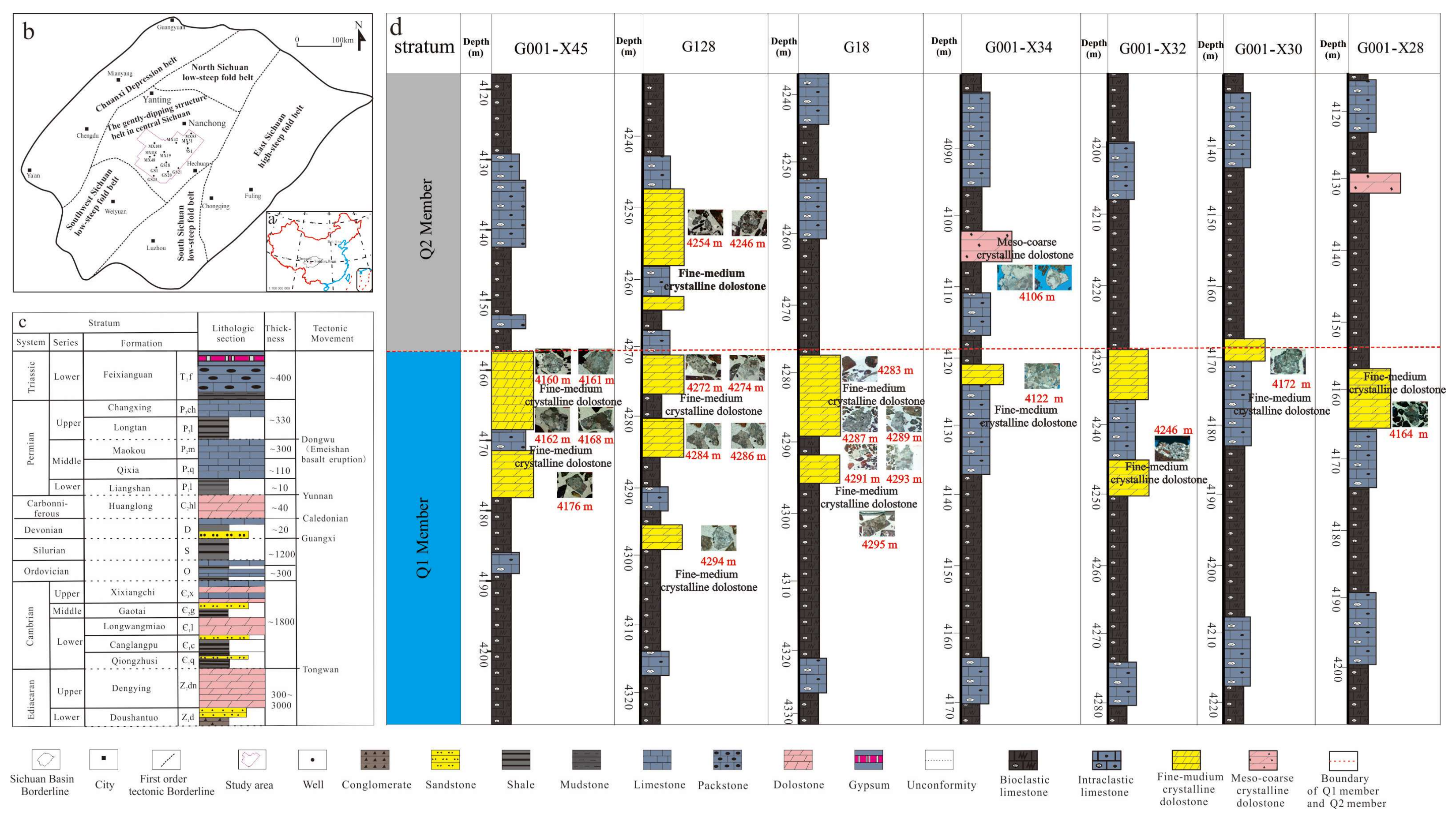
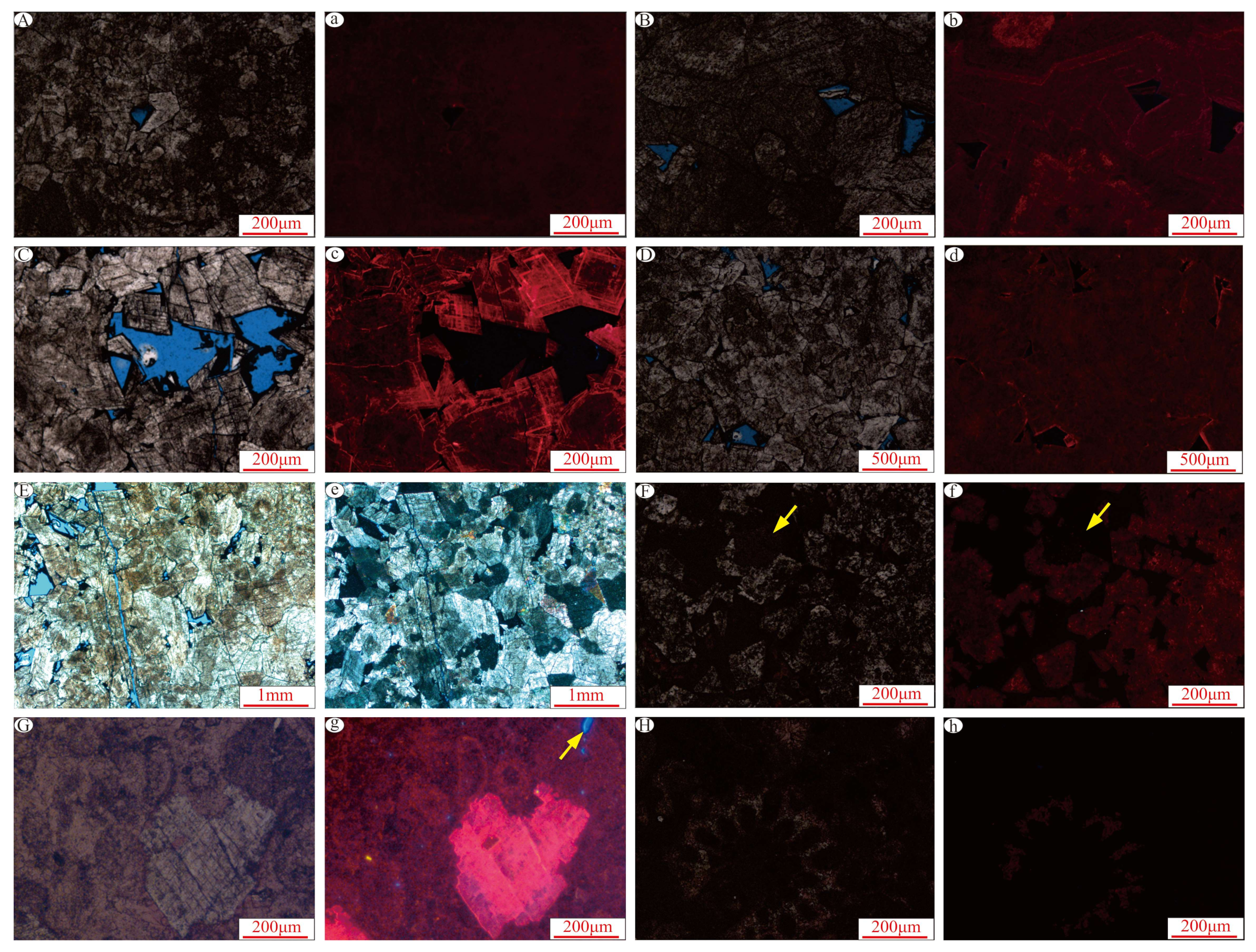
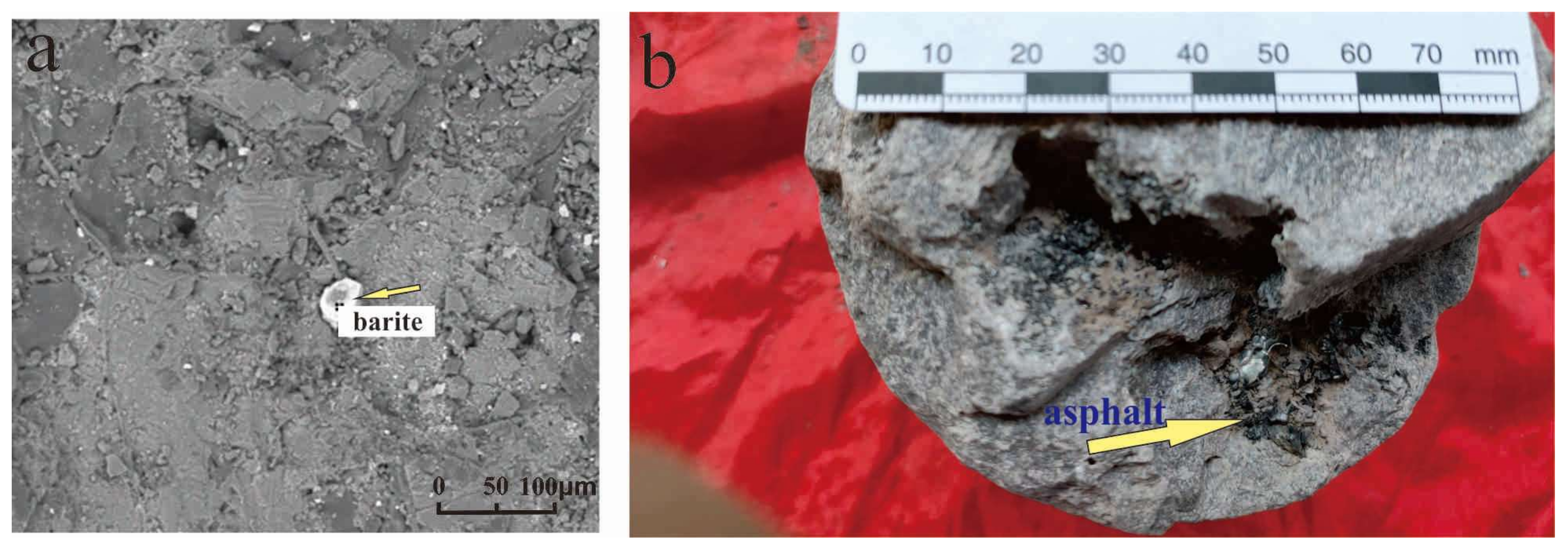
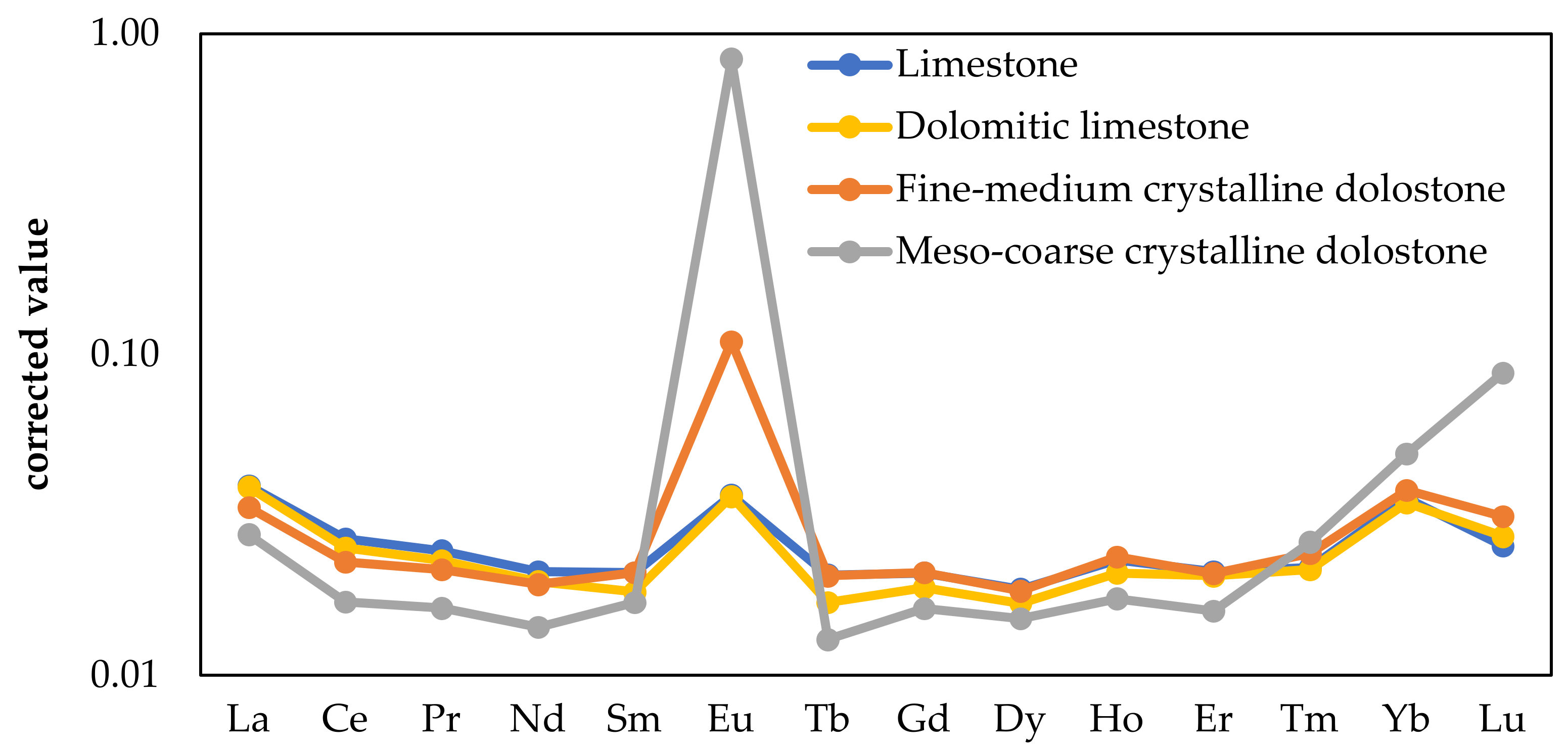
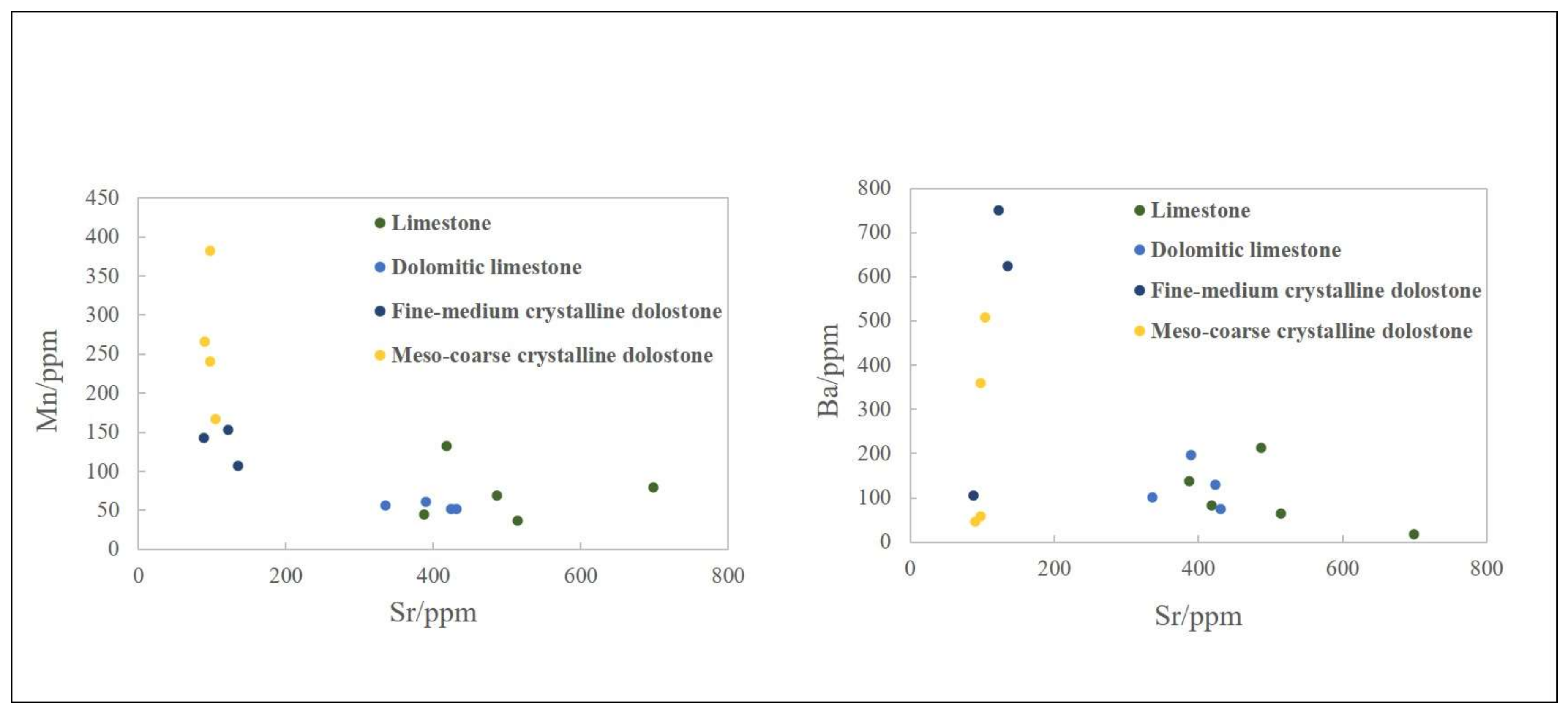
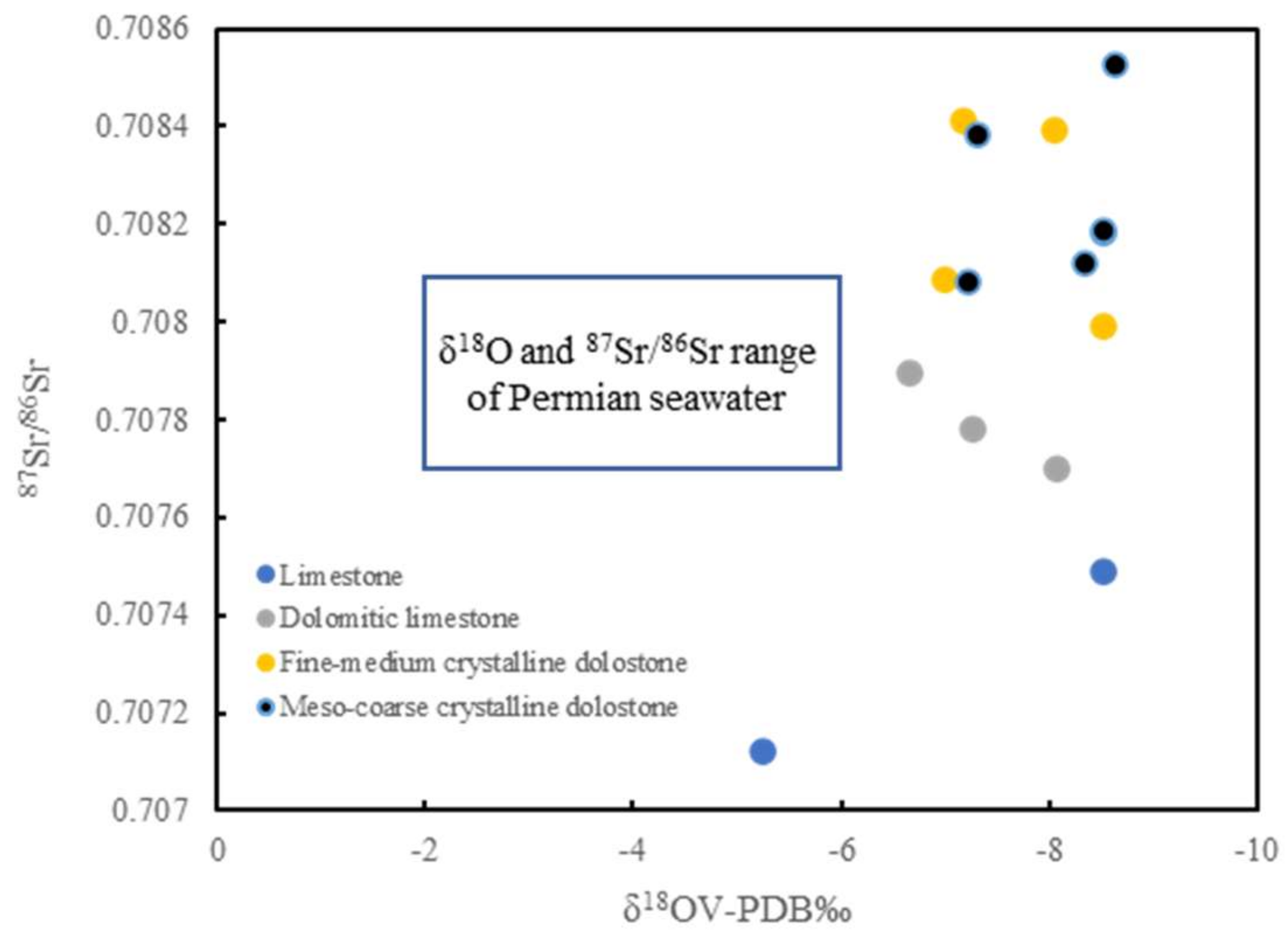
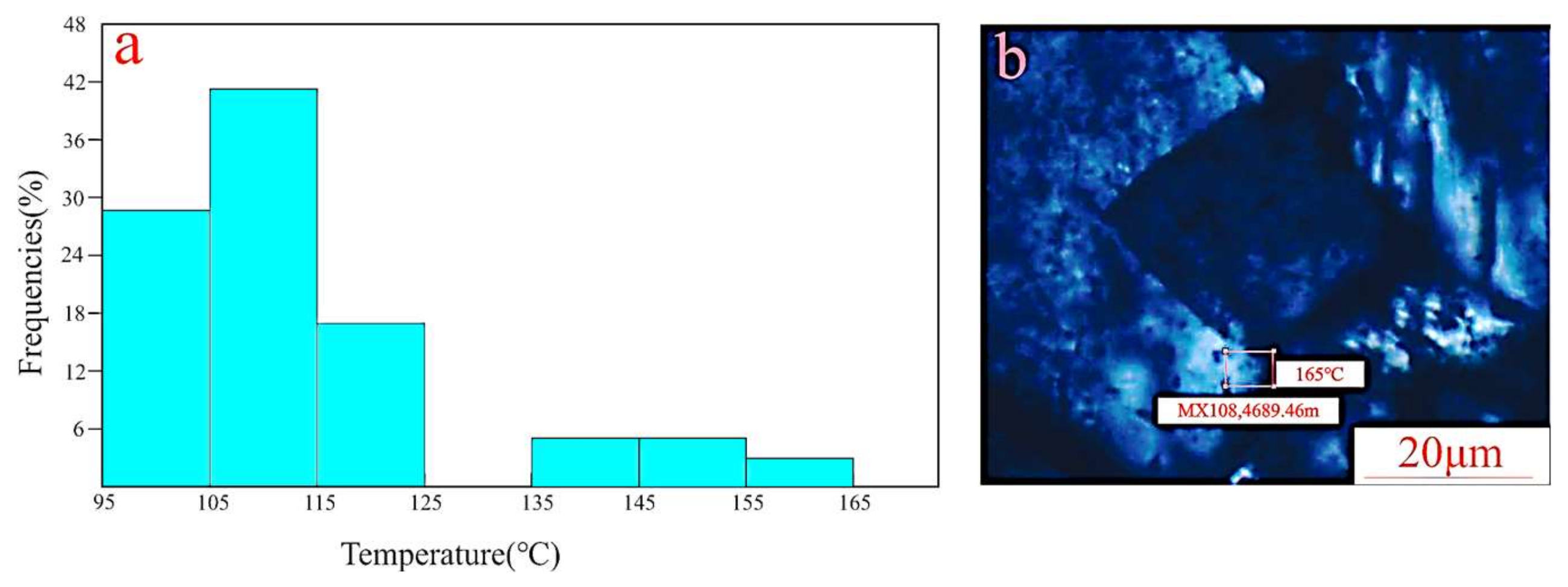
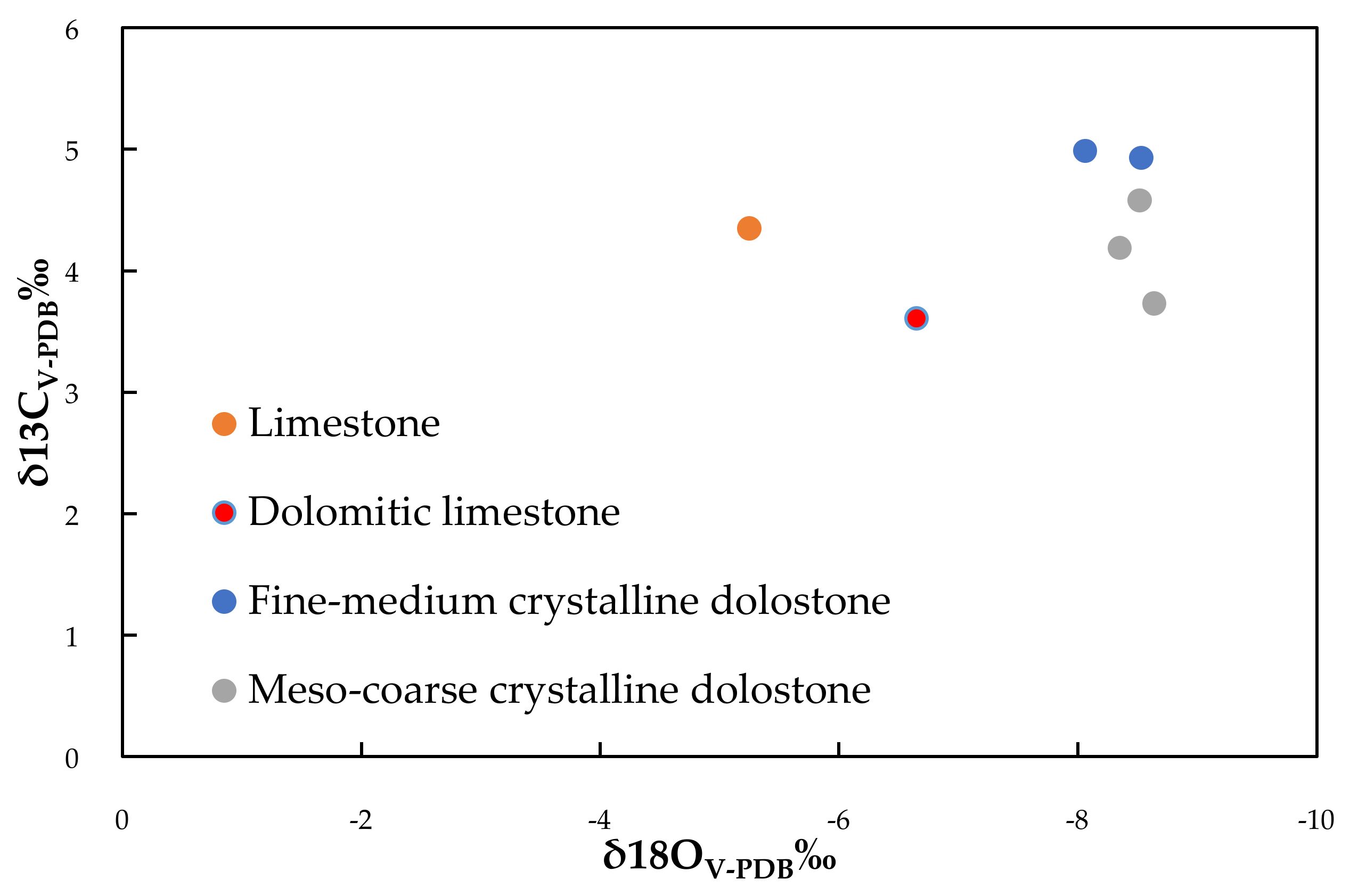
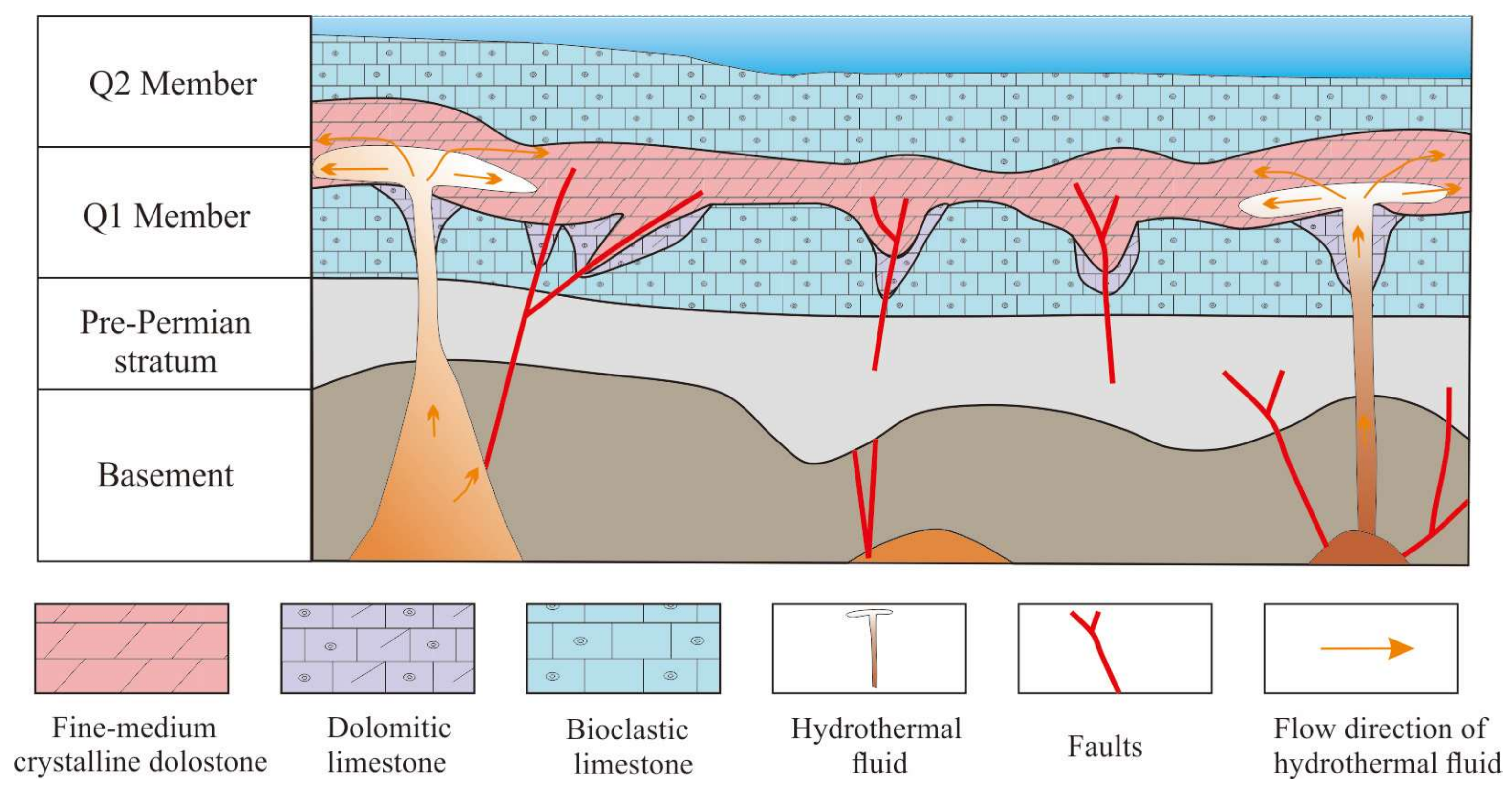
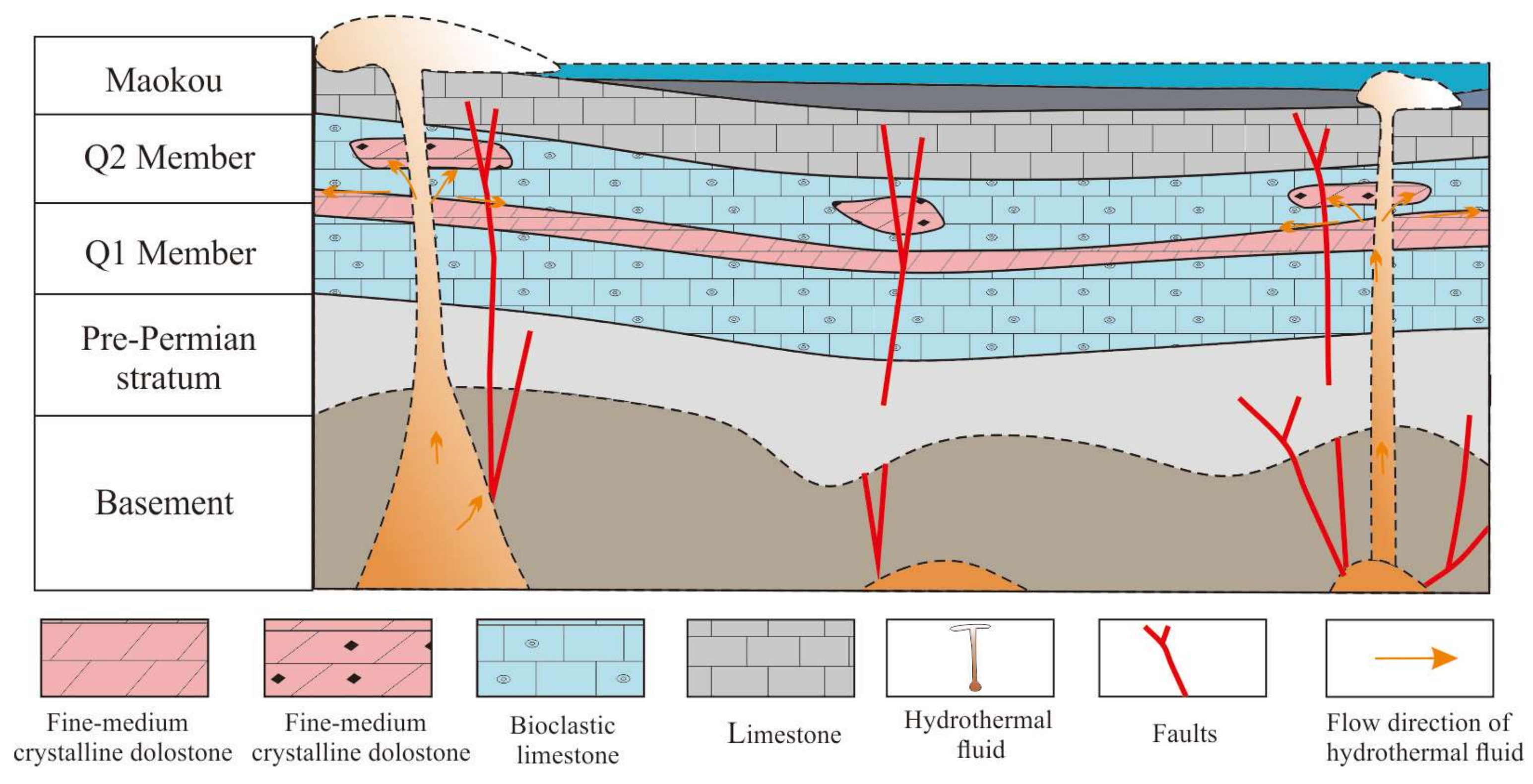
| Well | Depth (m) | Lithologies | Magnification | Material | C/% | O/% | S/% | Cl/% | Ca/% | Au/% | Si/% | Al/% | Ba/% |
|---|---|---|---|---|---|---|---|---|---|---|---|---|---|
| MX42 | 4651.2 | Fine-medium crystalline dolostone | 600 | Barite | 9.95 | 28.45 | 10.33 | 0 | 0.44 | 8.55 | 0.34 | 0.45 | 41.49 |
| MX42 | 4651.2 | Fine-medium crystalline dolostone | 600 | Asphalt or oil trace | 80.3 | 5.19 | 8.13 | 0.41 | 0.49 | 5.49 | 0 | 0 | 0 |
| Well | Depth (m) | Lithologies | Order Degrees of Dolostones (δ) |
|---|---|---|---|
| MX42 | 4650.50 | Meso-coarse crystalline dolostone | 0.93 |
| MX42 | 4651.20 | Meso-coarse crystalline dolostone | 0.82 |
| MX42 | 4655.42 | Fine-medium crystalline dolostone | 0.69 |
| MX42 | 4655.62 | Meso-coarse crystalline dolostone | 0.93 |
| MX42 | 4659.68 | Fine-medium crystalline dolostone | 0.79 |
| MX108 | 4671.8 | Fine-medium crystalline dolostone | 0.77 |
| MX108 | 4689.46 | Meso-coarse crystalline dolostone | 0.84 |
| MX108 | 4690.78 | Meso-coarse crystalline dolostone | 0.82 |
| Rare Earth Element Concentration (µg/g) | Rare Earth Element Parameters | |||||||||||||||||||||
|---|---|---|---|---|---|---|---|---|---|---|---|---|---|---|---|---|---|---|---|---|---|---|
| Well | Depth (m) | Lithologies | La | Ce | Pr | Nd | Sm | Eu | Tb | Gd | Dy | Ho | Er | Tm | Yb | Lu | ∑ REE | ∑ LREE | ∑ HREE | ∑LREE/∑HREE | δEu | δCe |
| MX108 | 4657.5 | Limestone | 0.03 | 0.02 | 0.02 | 0.02 | 0.02 | 0.02 | 0.02 | 0.02 | 0.01 | 0.02 | 0.01 | 0.02 | 0.03 | 0.02 | 0.26 | 0.12 | 0.15 | 0.79 | 1.11 | 0.86 |
| MX108 | 4664.19 | Limestone | 0.05 | 0.03 | 0.04 | 0.03 | 0.03 | 0.03 | 0.03 | 0.03 | 0.03 | 0.03 | 0.03 | 0.03 | 0.05 | 0.04 | 0.48 | 0.21 | 0.27 | 0.78 | 1.04 | 0.85 |
| MX108 | 4671.16 | Fine-medium crystalline dolostone | 0.03 | 0.02 | 0.02 | 0.02 | 0.02 | 0.11 | 0.02 | 0.02 | 0.02 | 0.02 | 0.02 | 0.02 | 0.03 | 0.03 | 0.41 | 0.23 | 0.18 | 1.31 | 6.14 | 0.83 |
| MX108 | 4675.9 | Dolomitic limestone | 0.02 | 0.02 | 0.02 | 0.01 | 0.01 | 0.04 | 0.02 | 0.02 | 0.02 | 0.02 | 0.02 | 0.03 | 0.04 | 0.03 | 0.33 | 0.13 | 0.2 | 0.66 | 2.73 | 0.83 |
| MX108 | 4681.84 | Dolomitic limestone | 0.04 | 0.03 | 0.03 | 0.02 | 0.02 | 0.03 | 0.02 | 0.02 | 0.02 | 0.03 | 0.03 | 0.03 | 0.04 | 0.04 | 0.41 | 0.18 | 0.24 | 0.76 | 1.29 | 0.82 |
| MX108 | 4686.49 | Limestone | 0.04 | 0.03 | 0.03 | 0.02 | 0.03 | 0.04 | 0.03 | 0.03 | 0.03 | 0.03 | 0.03 | 0.03 | 0.04 | 0.03 | 0.42 | 0.18 | 0.24 | 0.77 | 1.51 | 0.83 |
| MX108 | 4689.46 | Meso-coarse crystalline dolostone | 0.03 | 0.02 | 0.02 | 0.02 | 0.03 | 0.08 | 0.02 | 0.03 | 0.02 | 0.03 | 0.02 | 0.03 | 0.04 | 0.03 | 0.44 | 0.21 | 0.23 | 0.94 | 3.17 | 0.84 |
| MX108 | 4690.65 | Limestone | 0.04 | 0.02 | 0.02 | 0.02 | 0.02 | 0.04 | 0.02 | 0.02 | 0.02 | 0.02 | 0.02 | 0.02 | 0.03 | 0.02 | 0.31 | 0.15 | 0.16 | 0.97 | 1.95 | 0.82 |
| MX42 | 4649.3 | Dolomitic limestone | 0.05 | 0.03 | 0.02 | 0.02 | 0.02 | 0.03 | 0.01 | 0.01 | 0.01 | 0.01 | 0.01 | 0.01 | 0.02 | 0.01 | 0.27 | 0.17 | 0.09 | 1.81 | 2.19 | 0.8 |
| MX42 | 4650.5 | Meso-coarse crystalline dolostone | 0.09 | 0.05 | 0.04 | 0.03 | 0.02 | 0.03 | 0.02 | 0.02 | 0.02 | 0.02 | 0.02 | 0.01 | 0.03 | 0.02 | 0.41 | 0.26 | 0.15 | 1.71 | 1.29 | 0.78 |
| MX42 | 4651.2 | Meso-coarse crystalline dolostone | 0.06 | 0.04 | 0.03 | 0.02 | 0.02 | 0.03 | 0.02 | 0.02 | 0.01 | 0.01 | 0.01 | 0.02 | 0.03 | 0.02 | 0.33 | 0.2 | 0.13 | 1.46 | 1.48 | 0.83 |
| MX42 | 4652.18 | Dolomitic limestone | 0.08 | 0.05 | 0.05 | 0.04 | 0.04 | 0.05 | 0.03 | 0.03 | 0.03 | 0.03 | 0.03 | 0.04 | 0.05 | 0.05 | 0.6 | 0.3 | 0.3 | 1 | 1.35 | 0.81 |
| MX42 | 4653.95 | Limestone | 0.04 | 0.03 | 0.02 | 0.02 | 0.01 | 0.04 | 0.01 | 0.01 | 0.01 | 0.02 | 0.01 | 0.02 | 0.03 | 0.02 | 0.3 | 0.17 | 0.14 | 1.22 | 3 | 0.9 |
| MX42 | 4655.42 | Fine-medium crystalline dolostone | 0.03 | 0.02 | 0.02 | 0.02 | 0.02 | 0.03 | 0.02 | 0.02 | 0.02 | 0.02 | 0.02 | 0.02 | 0.03 | 0.03 | 0.3 | 0.14 | 0.17 | 0.84 | 1.86 | 0.81 |
| MX42 | 4655.62 | Meso-coarse crystalline dolostone | 0.05 | 0.03 | 0.03 | 0.02 | 0.02 | 0.1 | 0.02 | 0.02 | 0.02 | 0.02 | 0.02 | 0.02 | 0.03 | 0.03 | 0.41 | 0.24 | 0.17 | 1.41 | 5.8 | 0.77 |
| MX42 | 4659.1 | Limestone | 0.04 | 0.02 | 0.02 | 0.02 | 0.02 | 0.05 | 0.02 | 0.02 | 0.02 | 0.02 | 0.02 | 0.02 | 0.03 | 0.02 | 0.35 | 0.18 | 0.17 | 1.07 | 2.73 | 0.78 |
| MX42 | 4659.68 | Fine-medium crystalline dolostone | 0.03 | 0.02 | 0.02 | 0.02 | 0.02 | 0.13 | 0.02 | 0.02 | 0.02 | 0.02 | 0.02 | 0.02 | 0.04 | 0.03 | 0.42 | 0.24 | 0.19 | 1.26 | 7.43 | 0.81 |
| Well | Depth (m) | Lithologies | δ13CV-PDB‰ | δ18OV-PDB‰ | 87Sr/86Sr |
|---|---|---|---|---|---|
| MX42 | 4649.3 | Dolomitic limestone | −1.32 | −7.26 | 0.707781 |
| MX42 | 4650.5 | Meso-coarse crystalline dolostone | −1.21 | −7.3 | 0.708383 |
| MX42 | 4651.2 | Meso-coarse crystalline dolostone | −1.21 | −7.23 | 0.70808 |
| MX42 | 4652.18 | Dolomitic limestone | −1.19 | −8.08 | 0.707699 |
| MX42 | 4655.42 | Fine-medium crystalline dolostone | −1.35 | −7.18 | 0.708412 |
| MX42 | 4655.62 | Meso-coarse crystalline dolostone | 4.58 | −8.52 | 0.708181 |
| MX42 | 4659.68 | Fine-medium crystalline dolostone | −1.41 | −6.99 | 0.708089 |
| MX108 | 4657.5 | Limestone | 4.35 | −5.25 | 0.707121 |
| MX108 | 4664.19 | Limestone | −2.62 | −8.53 | 0.70749 |
| MX108 | 4671.16 | Fine-medium crystalline dolostone | 4.93 | −8.53 | 0.70799 |
| MX108 | 4671.8 | Fine-medium crystalline dolostone | 4.99 | −8.06 | 0.708392 |
| MX108 | 4681.84 | Dolomitic limestone | 3.61 | −6.65 | 0.707894 |
| MX108 | 4689.46 | Meso-coarse crystalline dolostone | 4.19 | −8.35 | 0.708118 |
| MX108 | 4690.78 | Meso-coarse crystalline dolostone | 3.73 | −8.64 | 0.708526 |
| Well | Lithologies | Depth (m) | δ18O V-PDB‰ | δ18O -Caco3 | Ancient Seawater Temperature (°C) | Theoretical Diagenetic Temperature (°C) |
|---|---|---|---|---|---|---|
| MX108 | Meso-coarse crystalline dolostone | 4690.78 | −8.64 | −2.23 | 25.88 | 56.06 |
| MX42 | Fine-medium crystalline dolostone | 4659.68 | −6.99 | −0.58 | 18.43 | 47.54 |
| MX108 | Limestone | 4657.5 | −5.25 | 1.16 | 11.34 | 38.79 |
| MX108 | Limestone | 4664.19 | −8.53 | −2.12 | 25.36 | 55.49 |
| MX42 | Fine-medium crystalline dolostone | 4655.42 | −7.18 | −0.77 | 19.25 | 48.51 |
| MX42 | Meso-coarse crystalline dolostone | 4651.2 | −7.23 | −0.82 | 19.47 | 48.77 |
| MX42 | Dolomitic limestone | 4652.18 | −8.08 | −1.67 | 23.27 | 53.14 |
| MX108 | Fine-medium crystalline dolostone | 4671.16 | −8.53 | −2.12 | 25.36 | 55.49 |
| MX108 | Fine-medium crystalline dolostone | 4671.8 | −8.06 | −1.65 | 23.18 | 53.04 |
| MX42 | Meso-coarse crystalline dolostone | 4655.62 | −8.52 | −2.11 | 25.31 | 55.43 |
| MX108 | Dolomitic limestone | 4681.84 | −6.65 | −0.24 | 16.98 | 45.81 |
| MX42 | Dolomitic limestone | 4649.3 | −7.26 | −0.85 | 19.60 | 48.92 |
| MX42 | Meso-coarse crystalline dolostone | 4650.5 | −7.3 | −0.89 | 19.78 | 49.12 |
| MX108 | Meso-coarse crystalline dolostone | 4689.46 | −8.35 | −1.94 | 24.52 | 54.55 |
Publisher’s Note: MDPI stays neutral with regard to jurisdictional claims in published maps and institutional affiliations. |
© 2021 by the authors. Licensee MDPI, Basel, Switzerland. This article is an open access article distributed under the terms and conditions of the Creative Commons Attribution (CC BY) license (https://creativecommons.org/licenses/by/4.0/).
Share and Cite
Chen, P.; Fu, M.; Deng, H.; Xu, W.; Wu, D.; He, P.; Guo, H. The Diagenetic Alteration of the Carbonate Rocks from the Permian Qixia Formation as Response to Two Periods of Hydrothermal Fluids Charging in the Central Uplift of Sichuan Basin, SW China. Minerals 2021, 11, 1212. https://doi.org/10.3390/min11111212
Chen P, Fu M, Deng H, Xu W, Wu D, He P, Guo H. The Diagenetic Alteration of the Carbonate Rocks from the Permian Qixia Formation as Response to Two Periods of Hydrothermal Fluids Charging in the Central Uplift of Sichuan Basin, SW China. Minerals. 2021; 11(11):1212. https://doi.org/10.3390/min11111212
Chicago/Turabian StyleChen, Pei, Meiyan Fu, Hucheng Deng, Wang Xu, Dong Wu, Puwei He, and Hengwei Guo. 2021. "The Diagenetic Alteration of the Carbonate Rocks from the Permian Qixia Formation as Response to Two Periods of Hydrothermal Fluids Charging in the Central Uplift of Sichuan Basin, SW China" Minerals 11, no. 11: 1212. https://doi.org/10.3390/min11111212
APA StyleChen, P., Fu, M., Deng, H., Xu, W., Wu, D., He, P., & Guo, H. (2021). The Diagenetic Alteration of the Carbonate Rocks from the Permian Qixia Formation as Response to Two Periods of Hydrothermal Fluids Charging in the Central Uplift of Sichuan Basin, SW China. Minerals, 11(11), 1212. https://doi.org/10.3390/min11111212






